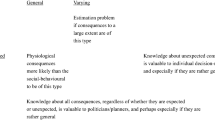Abstract
We argue that social norms must be measured at the group level of analysis, allow for a range of acceptable behaviors, and be linked to the individual level of analysis to explain social behavior. From a survey of young adults in Wisconsin (1973), we generated measures of family size norms from sibship experience and friends' expected family size. These measures satisfied our primary criterion for a social norm: Those with non-normative family size desires tended to shift expectations toward the norm. The analyses demonstrate the difficulty of estimating normative effects when by its very definition a norm is expected to restrict variation in human behavior.
Similar content being viewed by others
References
Blake, J., & K. Davis. (1964). Norms, values, and sanctions. In R.E.L. Faris (Ed.),Handbook of Modern Sociology (pp. 456–484). Chicago: Rand McNally.
Blake, J., & J.H. del Pinal. (1981). Negativism, equivocation, and wobbly assent: Public "support" for the prochoice platform on abortion.Demography, 18 309–320.
Calhoun, L.G., & J.W. Selby. (1980). Voluntary childlessness, involuntary childlessness, and having children: A study of social perceptions.Family Relations, 29(April 181–183.
Clay, D.C., & J.J. Zuiches. (1980). Reference groups and family size norms.Population and Environment, 3(Fall/Winter 262–279.
Cautley, P.W., & E.F. Borgatta. (1975). Role definitions and fertility orientations. Working Paper 75-36, Center for Demography and Ecology, University of Wisconsin, Madison, Wisconsin.
Coombs, C.H., L.C. Coombs, & G.M. McClelland. (1975). Preference scales for number and sex of children.Population Studies, 29 273–298.
Davidson, A.R., & J.J. Jaccard. (1975). Population psychology: A new look at an old problem.Journal of Personality and Social Psychology, 31(6 1073–1082.
Easterlin, R.A. (1978). What will 1984 be like? Socioeconomic implications of recent twists in age structure.Demography, 15 397–432.
Fried, E.S., & J.R. Udry. (1980). Normative pressures on fertility planning.Population and Environment, 3 (Fall/Winter 199–209.
Granberg, D., & B.W. Granberg. (1981). Pro-life versus Pro-choice: another look at the abortion controversy in the U.S.Sociology and Social Research 65 424–434.
Griffith, J. (1973). Social pressure on family size intentions.Family Planning Perspectives 5, (Fall 237–242.
Henley, J.R., Jr., & S.O. Gustavus. (1977). An exploratory technique for measuring fertility norms.Social Biology, 24(Summer 149–157.
Houseknecht, S.K. (1977). Reference group support for voluntary childlessness: Evidence for conformity.Journal of Marriage and the Family, 39(2 285–292.
Houseknecht, S.K. (1978). Voluntary childlessness: A social-psychological model.Alternative Lifestyles, 1(August 379–402.
Jackson, J. (1975). Normative power and conflict potential.Sociological Methods and Research, 4 237–263.
Mason, K.O. (1983). Norms relating to the desire for children. In R.A. Bulatao and R.D. Lee (Eds.),Determinants of Fertility in Developing countries. Vol. 1. Supply and Demand for Children. (pp. 388–428). New York: Academic Press.
Parsons, T. (1951).Social Structure. Glencoe, Illinois: The Free Press.
Potter, R.G., Jr., & J.F. Kautner. (1955). The influence of siblings and friends on fertility.The Milbank Memorial Fund Quarterly, 33 246–267.
Rossi, P.H., & R.A. Berk. (1985). Varieties of normative consensus.American Sociological Review, 50 333–347.
Trent, R.B. (1980). Evidence bearing on the construct validity of ideal family size.Population and Environment, 3(Fall/Winter 309–327.
Udry, J.R. (1982). The effect of normative pressures on fertility.Population and Environment, 5 109–122.
Veevers, J.E. (1980).Childless by Choice. Scarborough, Ontario: Buttersworths.
Author information
Authors and Affiliations
Rights and permissions
About this article
Cite this article
Thomson, E., Goldman, P. Measuring fertility norms. Popul Environ 9, 173–185 (1987). https://doi.org/10.1007/BF01259307
Issue Date:
DOI: https://doi.org/10.1007/BF01259307




